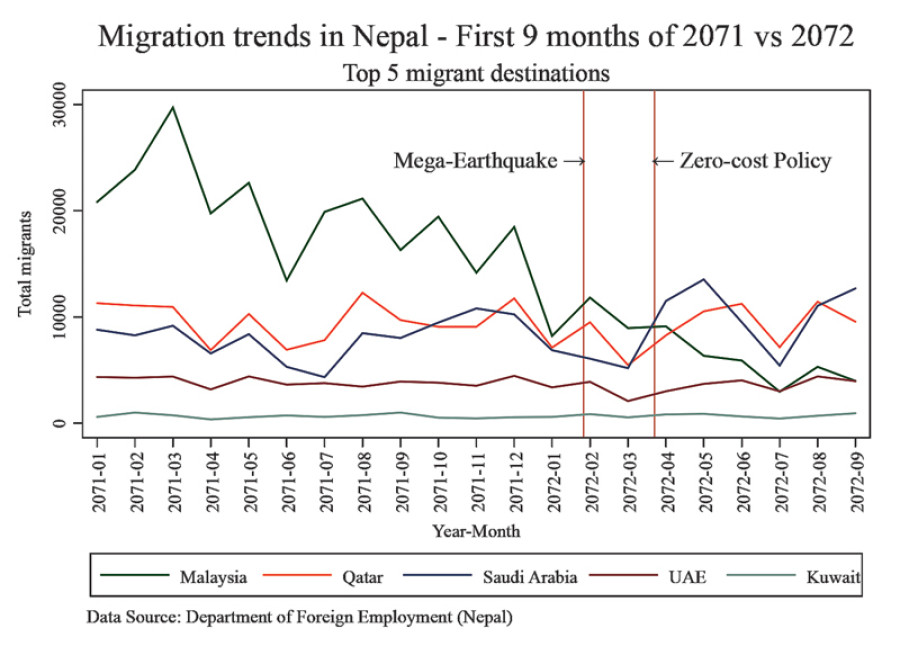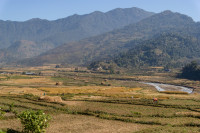Opinion
Missing migrants
Lack of data to understand migration process is hurting policies governing labour migrants
Samik Adhikari
The number of Nepali migrants leaving for jobs abroad has been increasing every year. It has nearly doubled in recent years from 294,094 in 2066 BS to 527,814 in 2070 BS. For the first time in over five years, the number of Nepali migrants receiving permits to work abroad fell in 2071 BS, and if the current trend continues, it is likely to drastically decrease in the fiscal year 2072 BS.
Compared to the period of first nine months of 2071 BS, when a total of 389,468 migrants received labour permits from the Department of Foreign Employment (DoFE) to work abroad, only 268,504 migrants have received their permits in the first nine months of 2072 BS. This dip is almost exclusively a consequence of the decrease in foreign labour migrants going to Malaysia—the most popular destination for Nepali labour migrants, hosting more of them in 2071 BS than the combined number of Nepali workers in Qatar and Saudi Arabia. However, in the first nine months of 2072 BS, both Qatar and Saudi Arabia have hosted significantly more Nepali migrants than Malaysia.
Debunking narratives
Although the earthquake in April caused a brief dip in labour migrants receiving permits to go to major destination countries, the trend quickly picked up to pre-earthquake levels for most countries except Malaysia. But if we look at the data, we see that the decline in Nepali labour migrants going to Malaysia started much before the earthquake.
The Nepal Association of Foreign Employment Agencies (NEFEA) has been vocal in its lobby against the zero-cost migration policy, which came into effect in Asad 2072 BS. According to NEFEA, the steep decline in Nepali migrants going to Malaysia is a direct consequence of a lack of willingness of Malaysian employers to bear the costs of migration for Nepali migrants.
To assess this claim, some form of cause-effect analysis is needed. Indeed, the data show that after the implementation of the zero-cost policy, there has been a further dip in Nepali labour migrants going to Malaysia. But attributing this dip directly to the zero-cost policy is a bad inference, especially when the context is taken into account.
First, there is no such dip in labour migrants going to other destination countries, which are also a part of the same policy. Second, there is plenty of anecdotal evidence to suggest that village agents of manpower agencies still charge exorbitant fees to link migrants with employers abroad. In this regard, the only change that the zero-cost policy seems to have brought is in the vouchers migrants receive for paying these fees, which now read Rs20,000 instead of Rs120,000.
More importantly, this dip can also be partially attributed to Malaysia having struck a deal with other labour sending countries in Asia, especially Bangladesh, to recruit more workers. In the market for migrant labourers, Bangladeshi migrants have increasingly paid higher costs and accepted lower-paying jobs in comparison to Nepali migrants.
Moving forward
It is tragic and ironic that in a country where almost one-third of the working age male population is migrants, and where remittances contribute to more than one-fourth of the GDP, the most reliable statistics on migration is the number of coffins that arrive at the international airport every day. This naturally, and justifiably, leads to concerns over exploitation of migrants in foreign countries. However, only raising issues of exploitation and abuse abroad misses the point. For migrant workers, the story of abuse very much starts at home, and the government is somewhat complicit in all this due to its blatant negligence and lack of understanding of the migration process.
There is obviously no simple solution to this conundrum. But there are so many pieces in the migration puzzle that even solving a part of it provides a big bang for the buck.
First, it is almost criminal that there has been no nationally representative study of labour migrants at the household level since the Nepal Migrant Survey implemented by the World Bank and the National Institute of Development Studies in 2065 BS. Other nationally representative surveys such as the Nepal Living Standard Survey (NLSS) have only devoted a few questions on migration, which is not enough to understand the big picture.
Second, the wide availability of mobile phone networks and remittance agencies in rural corners of Nepal provides a golden opportunity to collect more data on the migration process.
Mobile phone penetration has rapidly increased in Nepal over the last decade and can be used as an accountability tool to generate data on migration costs at each step of the migration process. Similarly, according to the NLSS, close to 90 percent of the migrant labourers in the Gulf and Malaysia now use remittance agencies to remit money to Nepal. Unlike labour recruitment—or “manpower”—agencies, remittance agencies are fairly well-regulated and have managed to keep the cost of sending remittances low for the migrants. So remittance agencies can be useful allies in learning about migrants, and in collecting information from them, once they reach the destination countries to check if the promises they were made before departure were fulfilled.
In the aftermath of the earthquake, remittances from hard-working migrants abroad helped keep many affected families in rural areas afloat. Sadly, migrants have been let down by the government’s inability to properly track different hurdles in the migration process. It is surely never a bad time to starting helping those who help their country.
Adhikari is a graduate of the MPA/ID programme at Harvard and is senior research associate at Social Progress Imperative, Washington DC




 18.12°C Kathmandu
18.12°C Kathmandu










